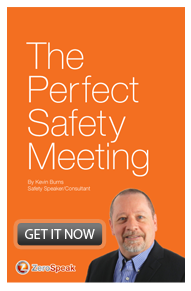When apathy and mediocrity run rampant, morale hovers near rock bottom - right next to safety.

Without getting into long descriptions, good workplace safety culture is the result of attitudes and personal and corporate values aligning. If apathy in the workplace exists, little care will be given to safety. When the quality of the work is “good enough,” apathy in safety exists. If employees think it's a lousy place to work, then safety will take a back seat. When apathy and mediocrity run rampant, morale hovers near rock bottom - right next to safety. When attitudes suck, good luck being a top performer - either in safety or financial performance. Hence, you have a broken safety culture.
You cannot change the culture without addressing the underlying attitudes and values. Attitudes, values and culture drive everything.
A 2013 study states that companies with strong attitudes outperform their competitors. Organizations with confident attitudes combined with a sense of service will outperform mediocre companies. According to the study, better performing companies have more engaged employees. Engaged employees are more productive and try harder.
Some companies are completely satisfied to remain mediocre or they would be choosing to improve. As long as the doors stay open, that seems to be good enough. As long as everyone has a job, good enough. As long as the company doesn't go belly-up, good enough.
Here are 6 reasons companies will never achieve safety greatness:
1They follow the pack. One mediocre organization checks to see what the others are doing with their safety program and does that. One follows the other, right or wrong. They have mediocre safety results. They hire mediocre people, expect mediocre results and equip their people to do a mediocre job. They are satisfied with sitting in the middle of the pack. They attract middle of the pack kind of people and get middle-of-the-pack ideas at their safety meetings.
2They are afraid to be great. Leading the pack makes them a target for other organizations to challenge. They don't like the spotlight and avoid it. Because being great comes with a price, people will attack those who are great. It is so much easier to tear down something great than it is to rise to greatness yourself. Yet those same companies complain that they can't find or keep enough good people. Great workplaces are able to attract and retain good, safe workers.
3They don’t see the relationship between employee engagement and production. The easiest way to engage an employee is to make him or her believe that the work means something. When people feel that their contribution matters, they engage better. When they engage, they take pride in their work. Then, they will protect that pride through buy-in to the safety program.
4They don’t see safety as a competitive advantage. Companies don’t want to affiliate with or do business with poor safety performers. Outstanding safety performance guarantees continued business and cash-flow. It also attracts better employees and encourages better performance.
5No company achieves safety greatness by cutting safety budgets. When senior management holds onto their cash it demonstrates how much they value their cash over their people. Once the economic situation recovers, they are surprised when their people take a job somewhere else.
6“Good enough” has become good enough. You have to want to be the best in your field to be one step better than mediocre. Sadly, most don't. They accept mediocre performance from their people. They accept mediocre ideas. They accept mediocre management. They accept wallowing somewhere in the middle of the pack as okay. They train their people to be simply competent in safety — not outstanding — just competent – and often miss that mark too.
Never is the best and greatest place to work an unsafe workplace. The worst places to work are those where safety investments are cut. Where managers and supervisors lack training in people skills. This results in a disconnect between managers and employees. Where there is a disconnect, there is uncertainty and people don’t feel protected. When people don’t feel protected, they don't feel safe. So, they leave. Turnover and attrition rises.

Simply put, the greatest place to work is always the safest place to work. The best places to work are where employees feel valued, cared for and protected. There are no exceptions to this rule. To attract and retain high-quality people, you have got to build a workplace that cares for and protects its employees. Investing in safety attracts and retains the best employees doing the best work.
The good news? To be outstanding, just be one step above mediocre. Anyone can win in that market. That should be encouraging news to any organization looking to be the best safety performer in their industry.
Kevin Burns is a management consultant, safety speaker and author of "The Perfect Safety Meeting." He delivers engaging and entertaining keynote safety presentations for everyone: from front-line staff to senior management. He helps people see the light when it comes to buying-in to the safety program.


